| Office of Management and Budget |
The Director of the Office of Management and Budget should take steps to promote, through mechanisms such as the Federal Privacy Council and Chief Information Officers Council, sharing of information and lessons learned to help agencies implement the requirements of the CASES Act; this could include SEC sharing information on overcoming challenges and identifying lessons learned. (Recommendation 1) |
|
| Department of Defense |
The Secretary of Defense should establish a reasonable time frame for when the Department of Defense will be able to accept remote identity proofing with authentication, digitally accept access and consent forms from individuals who were properly identity proofed and authenticated, and post access and consent forms on the department's privacy program website. (Recommendation 2) |
|
| Department of Health and Human Services |
The Secretary of Health and Human Services should establish a reasonable time frame for when the Department of Health and Human Services will be able to digitally accept access and consent forms from individuals who were properly identity proofed and authenticated and post access and consent forms on the department's privacy program website. (Recommendation 3) |
|
| Department of the Interior |
The Secretary of Interior should establish a reasonable time frame for when the Department of the Interior will be able to accept remote identity proofing with authentication, digitally accept access and consent forms from individuals who were properly identity proofed and authenticated, and post access and consent forms on the department's privacy program website. (Recommendation 4) |
|
| Department of Justice |
The Attorney General should establish a reasonable time frame for when the Department of Justice will be able to accept remote identity proofing with authentication, digitally accept access and consent forms from individuals who were properly identity proofed and authenticated, and post access and consent forms on the department's privacy program website. (Recommendation 5) |
|
| Department of Transportation |
The Secretary of Transportation should establish a reasonable time frame for when the Department of Transportation will be able to accept remote identity proofing with authentication, digitally accept access and consent forms from individuals who were properly identity proofed and authenticated, and post access and consent forms on the department's privacy program website. (Recommendation 6) |
|






